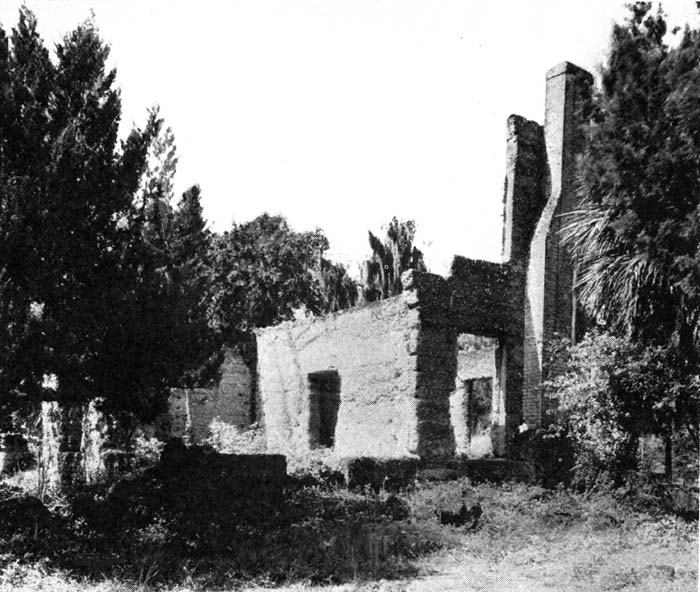Bradenton’s Legendary Past

By Sarah Fish
Nestled away in a sleepy community of mobile homes along the Manatee River, lies the remnants of what once stood a towering fortress. Serving as a winter trading post for citrus farmers and as protection from Native American attacks, Braden Castle now resembles a pile of old stones in the shape of a foundation, surrounded by metal fencing and deteriorating asphalt.
The ruins memorialize a big part of Bradenton’s legendary past and could be seen as a metaphor for much of the city’s history tucked away and often overlooked, but unique and impressive, nonetheless. Bradenton is more than just its nickname, “The Friendly City”; it is a significant location in American history.
“For me, the most important thing to remember about history, local or otherwise, is that context is everything,” says Phaedra Dolan, Director of Historical Resources for the Manatee County Clerk of Circuit Court and Comptroller. She says many people who visit Bradenton are aware of the Spanish Colonial era of local history, but the rich history of Bradenton is often overshadowed by the attraction of area theme parks.
“Our state has a fascinating history!” she says.
Only a couple miles away, a National Monument pays tribute to conquistador Hernando De Soto, who in 1539 landed nearby and was met by the resistance of the Calusa tribes who inhabited the lands. Uniquely, they are credited with engineering a canal system through which they and other indigenous people traveled the Florida territory.


Braden Castle Ruins Photos Courtesy of Florida Memory State Library and Archives of Florida
The Calusa are one of very few Native American tribes who did not rely on staple crops and animal husbandry to survive. Instead, they were master ship builders and engineered estuaries to capture and raise fish, using shells as their main tools. Multiple shell mounds still adorn local preserves to this day. A look into their ship building ways can be enjoyed at the Florida Maritime Museum just off Bradenton’s Cortez Road heading towards the beach. It is a peek into the importance of the area’s waterways. “The Gulf of Mexico has been a source of food, commerce, and transportation for centuries,” Dolan says.
The city was named after settlers Hector and Joseph Braden, of whom the latter ultimately built the now dilapidated Braden Castle in 1854. His brother, Hector, died crossing the Manatee River during a hurricane before Joseph began construction on the castle.
Legend has it that Hector and his horse became stuck in the muddy river bottom while the water was sucked out to sea during the eye of the storm. The pair drowned when water returned to the river, and it is said that both the horse and Hector, who was allegedly still gripping the reins, were discovered deceased with their eyes wide open. It is legends like that which make the Manatee River the subject of much of the area’s history. “The Manatee River has been the subject of legends, a safe haven, a highway, and a beacon for those who wished to settle here looking for a better life,” Dolan says.
“The Manatee River’s banks were dredged in the 1920s to accommodate larger ships, which led to the rapid growth of the City of Bradenton,” Dolan added. “To me, the most often overlooked piece of our local history is that of the role the Manatee River has played.”
At Bradenton’s Manatee Mineral Spring, this location was once the Maroon Community, Angola. It served as a safe haven for freedom-seeking African Americans from 1770 to 1821 and ultimately was destroyed during a massive slave raid. This still accessible spring provided life-sustaining water to Florida’s first settlers and Native Americans, Spanish explorers, and soldiers who fought in the Third Seminole and Civil Wars. In 2018, it was finally dedicated as a site on the Underground Railroad to Freedom, eleven years after a Black Bead tree on the property was added to the National Register of Big Trees.
Originally spelled “Braidenton” due to an officially documented error by the then acting secretary, the city was founded in 1842 upon applying for its own post office. The innocuous “I” was eventually dropped in 1905 after the trolly car system was built. Before closing the line due to lack of riders, the train once crossed Bradenton’s first bridge, newly rebuilt yet still located today cresting over Ware’s Creek.
“Bradentown will always be a small town until we take the “w” out!”
Confined to just over 12 square miles of land and nearly 3 acres of water, Bradenton maintains its small-town energy with big ambition, along with its rich and interesting history. Despite being small in size, Bradenton packs in nearly one dozen historical buildings and historic districts within its city limits including the Braden Castle Historic District, the Downtown Historic Old Main Street, and the Wares Creek neighborhood, among others. Nearly two dozen historical societies and groups have been officially chartered to preserve its history.
Today, the city boasts hosting the largest artists’ colony in the state of Florida, the Village of the Arts; it is training grounds to the Pittsburgh Pirates; and the local theater group, the Manatee Players, placed first in the Florida Theater Conference and Southeast Theater Competitions three years in a row as well as currently holding the first-place title from the American Association of Community Theater. We even have our own Roller Derby team, the Bradentucky Bombers, and recently laid to rest in 2017 the oldest manatee in captivity and one of the first recorded captive births, our beloved county mascot, Snooty.
Bradenton has been home to many prominent figures. Depending on who you consider famous, Dolan says, “From Billy Bowlegs (Holata Micco) and Polly Parker (Ma-De-Lo-Yee), two legendary members of the Seminole Tribe; to Babe Ruth and Dizzy Dean, who frequented the area during spring training – there’s a wide variety of “famous” personalities that are part of our local history.”
“If I had to pick a favorite, mine is probably Powell Crosley; inventor and radio pioneer, who lived on Sarasota Bay. Though he only spent winters in our area, his inventions were as varied as could be and simply fascinating. His Spanish-revival style estate on Sarasota Bay is one of my favorite pieces of architecture from Florida’s 1920s Land Boom era.” Dolan shared.
Tucked between St. Pete and Sarasota, Bradenton cannot help but be a significant part of the Culture Coast. It’s unique history and vibrant community of movers and shakers help make the city what it is today and has helped shape the course of American history as we know it.
